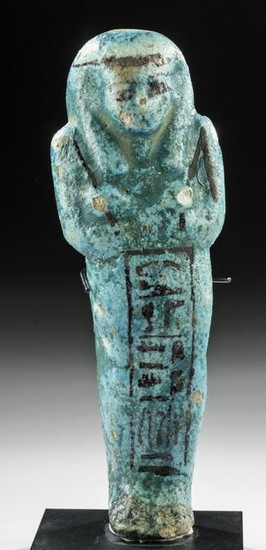Translated Egyptian Faience Ushabti for Amunmose
Ancient Egypt, Third Intermediate Period, 21st Dynasty, ca. 1069 to 945 BCE. An attractive example of a mold-formed faience ushabti covered in layers of reflective turquoise-hued glaze. The figure stands in mummiform with fused legs and feet, holds a black-painted pick and hoe in hands crossed atop the protruding chest, and bears a black seed bag hanging on the verso from both rounded shoulders. The minimalist countenance features slender eyes with elongated outer canthi, a petite nose, smooth cheeks that taper to a rounded chin, and a tall forehead adorned with a black head band, all framed within the lapels of a tripartite wig. A black-painted hieroglyphic inscription is enclosed with a thin box atop the front of the legs that, when translated, reads, "The Osiris, the prophet of Amun, Amunmose, true of voice." Size: 2.1" W x 5.75" H (5.3 cm x 14.6 cm); 6.6" H (16.8 cm) on included custom stand.
Shabti dolls (or ushabti) are figures shaped like adult male or female mummies wearing traditional ancient Egyptian headdresses. The ancient Egyptians believed that after they died, their spirits would have to work in the "Field of Reeds" owned by the god of the underworld, Osiris. This meant doing agricultural labor, which was required by all members of society, from workers to pharaohs. The wealthier nobility in Egyptian society were able to have shabtis made of coveted faience. Faience was known as "tjehnet" to the ancient Egyptians, meaning brilliant or dazzling. It was made by grinding quartz or sand crystals together with various elements, including copper oxide, which gave it its distinctive blue or blue-green tint. The Egyptians believed that blue faience reflected the color of the river Nile both on earth and in the afterlife, and funerary objects are often made from this material.
Provenance: private J.H. collection, Beaverton, Oregon, USA; ex-Sands of Time, Washington, D.C.; ex-private Minnesota, USA collection; ex-University of Minneapolis excavation collection, Minneapolis, Minnesota, USA, deaccessioned via public auction in the 1970s
All items legal to buy/sell under U.S. Statute covering cultural patrimony Code 2600, CHAPTER 14, and are guaranteed to be as described or your money back.
A Certificate of Authenticity will accompany all winning bids.
We ship worldwide to most countries and handle all shipping in-house for your convenience.
#149665
Condition Report: Minor abrasions to areas of original glaze, with light pitting, fading and some areas of darkening to original turquoise and black pigmentation commensurate with age and tomb conditions, and minor chips to hands, arms, feet, and head, otherwise intact and very good. Light earthen deposits as well as wonderful traces of original pigment throughout. Hieroglyphic inscription is still legible.
View it on
Estimate
Time, Location
Auction House
Ancient Egypt, Third Intermediate Period, 21st Dynasty, ca. 1069 to 945 BCE. An attractive example of a mold-formed faience ushabti covered in layers of reflective turquoise-hued glaze. The figure stands in mummiform with fused legs and feet, holds a black-painted pick and hoe in hands crossed atop the protruding chest, and bears a black seed bag hanging on the verso from both rounded shoulders. The minimalist countenance features slender eyes with elongated outer canthi, a petite nose, smooth cheeks that taper to a rounded chin, and a tall forehead adorned with a black head band, all framed within the lapels of a tripartite wig. A black-painted hieroglyphic inscription is enclosed with a thin box atop the front of the legs that, when translated, reads, "The Osiris, the prophet of Amun, Amunmose, true of voice." Size: 2.1" W x 5.75" H (5.3 cm x 14.6 cm); 6.6" H (16.8 cm) on included custom stand.
Shabti dolls (or ushabti) are figures shaped like adult male or female mummies wearing traditional ancient Egyptian headdresses. The ancient Egyptians believed that after they died, their spirits would have to work in the "Field of Reeds" owned by the god of the underworld, Osiris. This meant doing agricultural labor, which was required by all members of society, from workers to pharaohs. The wealthier nobility in Egyptian society were able to have shabtis made of coveted faience. Faience was known as "tjehnet" to the ancient Egyptians, meaning brilliant or dazzling. It was made by grinding quartz or sand crystals together with various elements, including copper oxide, which gave it its distinctive blue or blue-green tint. The Egyptians believed that blue faience reflected the color of the river Nile both on earth and in the afterlife, and funerary objects are often made from this material.
Provenance: private J.H. collection, Beaverton, Oregon, USA; ex-Sands of Time, Washington, D.C.; ex-private Minnesota, USA collection; ex-University of Minneapolis excavation collection, Minneapolis, Minnesota, USA, deaccessioned via public auction in the 1970s
All items legal to buy/sell under U.S. Statute covering cultural patrimony Code 2600, CHAPTER 14, and are guaranteed to be as described or your money back.
A Certificate of Authenticity will accompany all winning bids.
We ship worldwide to most countries and handle all shipping in-house for your convenience.
#149665
Condition Report: Minor abrasions to areas of original glaze, with light pitting, fading and some areas of darkening to original turquoise and black pigmentation commensurate with age and tomb conditions, and minor chips to hands, arms, feet, and head, otherwise intact and very good. Light earthen deposits as well as wonderful traces of original pigment throughout. Hieroglyphic inscription is still legible.



